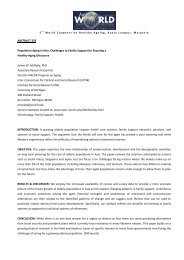Malaysian Healthy Ageing Society - 1st World Congress on Healthy ...
Malaysian Healthy Ageing Society - 1st World Congress on Healthy ...
Malaysian Healthy Ageing Society - 1st World Congress on Healthy ...
You also want an ePaper? Increase the reach of your titles
YUMPU automatically turns print PDFs into web optimized ePapers that Google loves.
Organised by:<br />
Co-Sp<strong>on</strong>sored:<br />
<str<strong>on</strong>g>Malaysian</str<strong>on</strong>g> <str<strong>on</strong>g>Healthy</str<strong>on</strong>g> <str<strong>on</strong>g>Ageing</str<strong>on</strong>g> <str<strong>on</strong>g>Society</str<strong>on</strong>g>
Preventi<strong>on</strong> of<br />
Adolescent substance<br />
abuse<br />
A/P Dr. Philip George<br />
Internati<strong>on</strong>al Medical<br />
University
Causes for use<br />
• Surveys suggest initiati<strong>on</strong> thru’ “gateway<br />
drugs” – tobacco, alcohol & inhalants<br />
• Peer pressure<br />
• Family risk factors<br />
• Biological - reduced serot<strong>on</strong>in (Goodwin<br />
1985)<br />
• Psychiatric illness (c<strong>on</strong>duct dis, ADHD,<br />
depressi<strong>on</strong>)
Gateway Theory<br />
• Kandel (1982)<br />
• Cigarettes & Alcohol first.<br />
• Developmental stages<br />
– Beer or Cigarettes<br />
– Wine or hard liquor<br />
– Marijuana & solvents<br />
– Other illicit drugs
Parental influences<br />
• Parental attitudes towards substances<br />
– Exposure<br />
– N<strong>on</strong>-fulfillment of resp<strong>on</strong>sibilities<br />
– ‘Salience’ (Ahmed et al, 1984) – number of household users of a<br />
substance & degree of child’s involvement<br />
• Parental-child interacti<strong>on</strong>s<br />
– Lack of warm relati<strong>on</strong>ship<br />
– Insecure attachment<br />
– Harsh, inc<strong>on</strong>sistent discipline<br />
– Inadequate supervisi<strong>on</strong><br />
– Marital c<strong>on</strong>flict<br />
– Physical / sexual abuse
Peer Pressure<br />
• Effect <strong>on</strong> the initiati<strong>on</strong>, development and<br />
maintenance of substance use<br />
• Socializati<strong>on</strong> or interpers<strong>on</strong>al selecti<strong>on</strong><br />
• Susceptibility due to<br />
– Involvement in peer-related activities<br />
– Attachment & reliance to peers rather than parents.<br />
• Substance abuse positively related to risk taking<br />
behaviour, sensati<strong>on</strong> seeking, higher value of<br />
independence, delinquency.
FRONTAL LOBE<br />
5/26/2012 Template copyright 2005<br />
www.brainybetty.com<br />
7
Genetic & biological causes<br />
• Dopamine release from the medial part of the<br />
nucleus accumbens is critical for the reinforcing<br />
effects of opioids.<br />
• It is suggested that all positive reinforcement<br />
associated with food, reward and sex depends<br />
too <strong>on</strong> this circuit.<br />
• Dopamine release in the mesolimbic system<br />
facilitate learning towards important events<br />
leading to wanting and craving in the dependent.
Synapse in nucleus accumbens in the brain<br />
Three types of neur<strong>on</strong>s participate in opiate acti<strong>on</strong>: <strong>on</strong>e that releases<br />
dopamine(L), neighboring terminal(R) c<strong>on</strong>taining GABA and<br />
post synaptic cell c<strong>on</strong>taining dopamine receptors(below)
Temperament<br />
• Temperament deviati<strong>on</strong>s a/w increased psychopathology<br />
and substance abuse<br />
• Risk for substance abuse<br />
– Increased behavioural activity level<br />
– Increased impulsivity<br />
– Reduced attenti<strong>on</strong> span<br />
• C<strong>on</strong>comittant psychiatric morbidity<br />
– Depressi<strong>on</strong><br />
– Anxiety disorder<br />
(Reich et al, 1993)
Prevalence of substance use<br />
am<strong>on</strong>g sec<strong>on</strong>dary school students<br />
in a rural area of Malaysia<br />
Department of Psychiatry,<br />
Clinical School,<br />
Internati<strong>on</strong>al Medical University<br />
Seremban<br />
Dr. Philip George<br />
Ms. Lim Kah Yen,<br />
Mr. Ding Ming Tat,<br />
Mr. Siva Saravana Kumar
Objectives<br />
The objectives of this study were:<br />
1.to determine the type of substance used by<br />
rural school children,<br />
2.to determine the differences in substance<br />
use am<strong>on</strong>g genders and age groups,<br />
3.to identify possible reas<strong>on</strong>s for abuse.
Methodology<br />
• Three sec<strong>on</strong>dary co-ed schools in a rural area of Negri Sembilan in<br />
Malaysia were chosen. (Choice determined by accessibility)<br />
• Permissi<strong>on</strong> was obtained from the school authorities, local Educati<strong>on</strong><br />
Department & from the Ministry of Educati<strong>on</strong> Malaysia<br />
• A total of 1091 pupils were selected from sec<strong>on</strong>dary school, of both<br />
gender, and ages between 14 to 17 years old. All students were included<br />
except those absent <strong>on</strong> the day of survey.<br />
• Resp<strong>on</strong>dents were required to answer a 5-page questi<strong>on</strong>naire and all<br />
informati<strong>on</strong> is kept c<strong>on</strong>fidential. They are also told to be as truthful as<br />
possible.
Sample Characteristics<br />
No.of resp<strong>on</strong>dents = 1091, but sample size = 1070<br />
21 forms were rejected because of invalid data entry<br />
Race<br />
• Malay = 925 (89.6%)<br />
• Chinese = 56 (2.9%)<br />
• Indian = 87 (7.3%)<br />
• Others = 2 (0.2%)<br />
Gender<br />
• Male = 654 (64.2%)<br />
• Female = 416 (35.8%)
RESULTS<br />
• 37.9% (406 students) use licit<br />
and illicit substances<br />
Number of students who abuse<br />
substances<br />
• Tobacco = most widely used,<br />
with 25% (268 students)<br />
• Inhalants = 7.1% (76 students)<br />
• Alcohol = 4.9% (52 students)<br />
number of<br />
students<br />
300<br />
250<br />
200<br />
150<br />
100<br />
50<br />
0<br />
268<br />
52<br />
76<br />
10<br />
Smoking Alcohol Drugs Inhalents<br />
• Illicit drugs = 0.9% (10 students)<br />
Type of substances
RESULTS : Tobacco Use<br />
• 25 % (268 students)<br />
• 64% of the smokers = male<br />
36% = female
RESULTS : Tobacco Use<br />
When did they start smoking?<br />
• 45.8% (120) of the<br />
smokers started between<br />
13-17 years of age<br />
• 44.7% (117) started<br />
between 9-12 years old.<br />
• 20 students smoked first<br />
between 5 to 8 years of<br />
age.<br />
number of<br />
smokers<br />
Age group when students start smoking<br />
120<br />
100<br />
80<br />
60<br />
40<br />
20<br />
0<br />
25<br />
117 120<br />
5-8 years old 9-12 years old 13-17 years old<br />
age group
RESULTS : Tobacco Use<br />
How many sticks a day?<br />
• < 5 sticks/day = 81.7% (188)<br />
• 6-10 sticks/day = 10.9% (25)<br />
• > 10 sticks/day = 4.3% (17)
RESULTS : Tobacco Use<br />
Reas<strong>on</strong>s for starting smoking?<br />
• 68.4% (162) : Peer pressure<br />
• 44.5% (105) : To release tensi<strong>on</strong> / relieve stress<br />
• 21.9% (52) : To overcome depressi<strong>on</strong><br />
• 9.2% (23) : To try (curious)<br />
• Other answers : feel sleepy, to become thinner, to show off,<br />
for fun, for style, c<strong>on</strong>trol anger, obtain peace of mind
RESULTS : Inhalants<br />
• 7.1 % (76 students)<br />
• Females (51.2% ) inhaled substances<br />
more than<br />
• males (48.8%)
RESULTS : Inhalants<br />
What are the types of inhalants used?<br />
• Petrol = 36% (52)<br />
• Correcti<strong>on</strong> pen fluid = 33% (49)<br />
• Gum = 26% (39)<br />
• Kerosene = 5% (8)<br />
• Other answers =<br />
perfume, cow dung,<br />
tar, marker pen.<br />
33%<br />
5%<br />
Types of inhalents abused<br />
36%<br />
26%<br />
Gum<br />
Petrol<br />
Kerosene<br />
Correcti<strong>on</strong> pen fluid
RESULTS : Inhalants<br />
Reas<strong>on</strong>s to start inhaling inhalants?<br />
• To release tensi<strong>on</strong> / relieve stress = 24.6% (16)<br />
• Peer pressure = 24.6% (16)<br />
• To overcome depressi<strong>on</strong> = 20% (13)<br />
• Other answers : tempting smell, curiosity,<br />
better sports performance, for fun, accidentally
RESULTS : Alcohol<br />
• 4.9% (52 students)<br />
• More am<strong>on</strong>g the Chinese students.<br />
• Am<strong>on</strong>g the Indian students, males drink more<br />
alcohol compared to their female counterparts.<br />
• However am<strong>on</strong>g Chinese students 57.9%; of<br />
females use alcohol compared to 42.1% males
RESULTS : Alcohol<br />
Reas<strong>on</strong>s to start drinking alcohol?<br />
• 70.8% (34) : Cultural (eg festivals,functi<strong>on</strong>s)<br />
• 31.3% (15) : To release tensi<strong>on</strong> / relieve<br />
stress<br />
• 22.9% (11) : Peer pressure<br />
• 12.5% (6) : To overcome depressi<strong>on</strong>
RESULTS : Alcohol<br />
Types of Alcohol used<br />
• Beer = 43%<br />
• Wine = 36%<br />
• Whisky = 11%<br />
• Cheap liquor = 10%<br />
Types of alcohol abused<br />
Wine<br />
36% Beer<br />
Beer<br />
43%<br />
Whisky<br />
Liquor<br />
10%<br />
Whisky<br />
11%<br />
Liquor<br />
Wine
ILLICIT DRUGS
RESULTS : Illicit drugs<br />
• 0.9% (10 students)<br />
• 8 males, 2 females<br />
• Substance used = amphetamine-type substance (3),<br />
Ganja (2) , Heroin (1), cough mixture (c<strong>on</strong>taining codiene)(1)<br />
• Reas<strong>on</strong>s = curious (6), peer pressure (4),<br />
to relieve stress/pressure (4)
DISCUSSION
DISCUSSION : Tobacco<br />
Our results :<br />
• 25% smoked<br />
• 36% female<br />
• 44.5% started smoking due to stress or to relieve pressure<br />
Other studies (Tobacco CPG M’sia 2003) :<br />
• Some 49% of all adult males and 5% of all adult females<br />
are now current smokers.<br />
• Trend towards a rise in smoking am<strong>on</strong>g females.
DISCUSSION : Inhalants<br />
• In most studies, boys were <strong>on</strong>ly a little more likely to have tried<br />
volatile substances than girls, although in some the proporti<strong>on</strong>s<br />
were reversed, with girls experimenting more than boys (Kin and<br />
Navaratanam).<br />
• The 1990 Nati<strong>on</strong>al Household Survey <strong>on</strong><br />
Drug Use in the USA found that 7-8% of<br />
12 to 17-year-olds said they had used<br />
volatile substances (Beauvais F et al)<br />
• Surprisingly more females used inhalants<br />
than males.
Glue Sniffing, Sarawak Fighting A Losing Battle<br />
BERNAMA : May 02, 2005 13:12 PM<br />
• Glue was the cheapest & <strong>on</strong>e of the favorite addictive substance<br />
in Sarawak, (3 tins of glue for RM10 and easily available).<br />
• Factors included broken homes, poor parenting, unemployment<br />
and peer pressure.<br />
• Glue sniffers were getting younger with some as young as 10,<br />
compared with between 15 and 30 years old previously, adding<br />
that an average of four or five glue sniffers were sent to the<br />
agency m<strong>on</strong>thly for help.<br />
• In our survey, 13.4% (11) students first inhaled volatile<br />
substances in the ages of 5 to 8 years old.
DISCUSSION : Alcohol<br />
• In this study, 25% smoked and 4.9% used<br />
alcohol.<br />
• In an unpublished study (Philip et al) in two<br />
urban schools with 269 resp<strong>on</strong>dents, alcohol use<br />
was am<strong>on</strong>g 58.6% and smoking am<strong>on</strong>g 17.8%.
DISCUSSION : Illicit drugs<br />
• Close to 1% used illicit substances.<br />
Amphetamine type substances was the most<br />
comm<strong>on</strong> type.<br />
• One fault of this study was it didn’t look at<br />
use of licit substances before (Gateway<br />
theory).
Preventi<strong>on</strong> of Adolescent<br />
Substance Abuse
Effective interventi<strong>on</strong>s<br />
• ‘Just say no’ - simplistic and naïve<br />
• What is effective is<br />
– Providing accurate & unbiased informati<strong>on</strong><br />
– Build skills (decisi<strong>on</strong> making & communicati<strong>on</strong>)<br />
– Counseling<br />
– Improve access to health services (can your daughter /<br />
s<strong>on</strong> seek advise or treatment from the doctor <strong>on</strong> their<br />
own?)<br />
– Safe & supportive envir<strong>on</strong>ment with acceptable<br />
alternatives.
Mindset change<br />
• Success is change in behaviour<br />
• Means need to change from ‘zero<br />
tolerance’ to ‘harm reducti<strong>on</strong>’<br />
• Exclusi<strong>on</strong> policies d<strong>on</strong>’t work.<br />
– When you expel, suspend student from school,<br />
makes the young pers<strong>on</strong> even more vunerable,<br />
more chance of higher substance use. They<br />
need to stay <strong>on</strong> in school and be kept engaged<br />
and rewarded
Effective educati<strong>on</strong><br />
• Use what has been shown to be effective<br />
• Comprehensive approach<br />
– School, community, parents, doctors<br />
• Timing of interventi<strong>on</strong><br />
– Before experimentati<strong>on</strong> and c<strong>on</strong>tinue as children grow<br />
• Realistic goals<br />
– Harm reducti<strong>on</strong> rather than abstinence al<strong>on</strong>e<br />
• Class teacher to provide
• Drug educati<strong>on</strong> must be interactive.<br />
• Young people can exchange views and<br />
experiences<br />
– Why can’t cannabis be legal?<br />
• Humane interventi<strong>on</strong> rather than exclusi<strong>on</strong>!<br />
Deterrent punishment yields no result.<br />
• Restorative justice vs punishment<br />
– Victims c<strong>on</strong>fr<strong>on</strong>t wr<strong>on</strong>gdoers
Preventi<strong>on</strong><br />
• Primary goal is to defer or prevent initiati<strong>on</strong> of<br />
gateway drugs (cigarettes & alcohol)<br />
• Traditi<strong>on</strong>al program<br />
– Increase knowledge of c<strong>on</strong>sequences of drug use<br />
• found to be ineffective ( Bangert-Downs, 1988)<br />
• Increased interest in drugs (Schinke et al, 1991)<br />
• Curriculum covering life skills and skills for<br />
resisting social influences to use drugs –<br />
significant reducti<strong>on</strong> in drug use 6 years later<br />
(Botwin et al, 1995)
Family interventi<strong>on</strong><br />
• Major source of c<strong>on</strong>nectedness and support<br />
• Not all family relati<strong>on</strong>ships are positive<br />
• Family substance abuse<br />
• Poor or inc<strong>on</strong>sistent parenting<br />
• Family c<strong>on</strong>flict<br />
• Lack of b<strong>on</strong>ding<br />
• Physical or sexual abuse<br />
• Identify other people – ‘social atom’
Parenting skills<br />
• Parenting skills – to empower parents to provide<br />
the support needed by adolescents and help<br />
prevent reliance <strong>on</strong> peers or substances.<br />
• To deal with c<strong>on</strong>flicts that can occur when the<br />
views of parents and the teenager differ.<br />
• Triple P Parenting – Positive Parenting Program<br />
(University of Queensland, Australia)<br />
www.triplep.net
Gatehouse Project (George Pat<strong>on</strong>)<br />
Social<br />
c<strong>on</strong>nectedness<br />
Bullying<br />
Measure /survey<br />
Social Acti<strong>on</strong><br />
Team<br />
Teachers, GP’s,<br />
Parents, MH<br />
professi<strong>on</strong>al.<br />
Not an extra<br />
program.<br />
Incorporated into<br />
curriculum. Life<br />
skills program.<br />
Best Practice at<br />
multiple levels
• Social c<strong>on</strong>nectedness as a protective factor<br />
– Family<br />
• Attachment<br />
• Family c<strong>on</strong>flicts<br />
– School / community<br />
- Family attitudes<br />
- Parenting skills<br />
• Engagement with teachers (teachers know you and<br />
encourage you)<br />
– Friends<br />
• Sensati<strong>on</strong> seeking<br />
• Identity and being bel<strong>on</strong>ged.
Prohibitive Preventi<strong>on</strong><br />
• Drink driving<br />
• C<strong>on</strong>trol <strong>on</strong> availability<br />
• Age<br />
• Taxes & cost<br />
• Laws regarding possessi<strong>on</strong> and use<br />
• Advertisement c<strong>on</strong>trols<br />
• Sp<strong>on</strong>sorships
Developing pers<strong>on</strong>al coping skills<br />
• Relaxati<strong>on</strong> training<br />
• Avoid cues – explore alternatives<br />
– People<br />
– Place<br />
– Time<br />
• Cognitive therapy<br />
– Become aware of negative thought<br />
– Interrupt that train of thought<br />
– Challenge the – thought & replace with + thought.
Other pers<strong>on</strong>al skills<br />
• Problem-solving skills<br />
• Recognise when a problem exists<br />
• Generate a variety of potential soluti<strong>on</strong>s<br />
• Select the most appropriate opti<strong>on</strong> and generate a plan<br />
for enacting it<br />
• Evaluate the effectiveness of the approach<br />
• Communicati<strong>on</strong>s skills<br />
• Assertiveness skills















